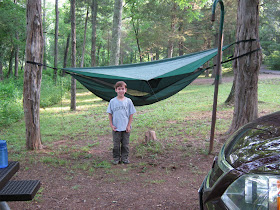I have written in a previous post about my Golite Ultra 20 down quilt. This has been a good quilt for me but, as others have noted, the temperature rating of 20 degrees was optimistic. I have read that the weight of down used was about 9.5 ounces (270 grams) of high quality (800 fill power) down. The Nunatak Arc Alpinist, a very well respected down quilt, has a 20 degree temperature rating with 11 ounces of down so I do think the people at Golite went a little cheap on the fill. (Because of widespread complaints the newer version of the quilt has more down I understand. The new version doesn't have the "20" in the name and is rated a 3-season quilt.).
This hadn't bothered me very much when sleeping on the ground but in a hammock it was a problem. The reason is that on the ground I put my ccf pad inside the quilt such that it forms a U-shape inside the footbox of the quilt such that my feet don't actually touch the quilt. In the hammock I don't do that and my feet were always cold. After investigating I realized that the baffles in the footbox were only partially filled with down. Here's a picture of my hand inside the footbox. You can clearly see the shape of my finger.

So I decided to buy some down from Thru-Hiker. He sells excellent quality down (900 fill power). The smallest bag you can get has 3.1 ounces in it. Here is the bag next to the quilt.

The mission was to put the down into the quilt. My wife was surprisingly willing to take on this project. She is a very competent seamstress. The first task was too pick open some seams with a "seam ripper" tool.

Once we had made a small hole we tried several methods of inserting the down. A funnel and a pencil worked pretty well but soon we realized that we could go even faster just using our fingers.

For those unfamiliar with the terminology of down sleeping bags and quilts you need to know that inside the quilt are "baffles" made of very fine mesh material. This keeps the down from shifting around too much and leaving cold spots. The areas between baffles, where the down is, are called "chambers". Most of the apparent "seams" you see in a down quilt aren't seams at all. They are just where you see the stitching that holds the baffles to the shell material of the quilt.
We filled the two chambers at the foot end (the part with black fabric) with extra down and then turned to the very bottom of the quilt, where the soles of you feet touch. This was somewhat laborious because there are three small chambers down there.

The quilt was definitely underfilled before. But I worried a bit about putting too much down in each chamber. At the foot end we certainly got close to doing that. If you overstuff the chambers then the down will not be able to fully loft and the insulating value of the down will be compromised. But afterward as I compare the feel of it to well-constructed winter down bags (such as those sold by Western Mountaineering) that I have handled it seems comparable.
The foot end was certainly the high priority. But after stuffing those chambers as full as we dared we still had at least half the down left. So we decided to continue on up the quilt and fill in the chambers that go across the body. This is made a little more difficult than you might think by one of the nice features of the Golite Ultra 20. Many quilts and bags have baffles only running across the body. But of course this means the down can shift to either side of you. The Golite Ultra 20 has additional baffles that run the length of the quilt and keep the down on top of you. This means that we couldn't open the seems at the very edge of the quilt and have access to those important top chambers. So we picked apart the seams where the lengthwise baffles meet the horizontal baffles.
The result is very nice looking. Because of the comparative emptiness of the quilt beforehand the "enhanced" quilt looks like the chambers are full without being overly full.

Inside the quilt feels positively luxurious. The material that Golite uses is very soft to the touch and now that the chambers are bulging with down your feet in particular feel like they are nestled in warmth. I'm really looking forward to trying the improved quilt this winter!
For those interested in tackling this project I will add two points.
1. Thru-hiker's down is REALLY excellent. The tufts of down are huge and fluffy and there are very few feathers to be seen. I highly recommend it. And the quantity (3 ounces) is just right for this project.
2. Working with down involves some clean up, as you can see from the pictures above. However I was surprised how easy it was. We have a Dyson, bagless vacuum cleaner and I was stunned at how well it worked. In just a few minutes the room was completely clean.















































